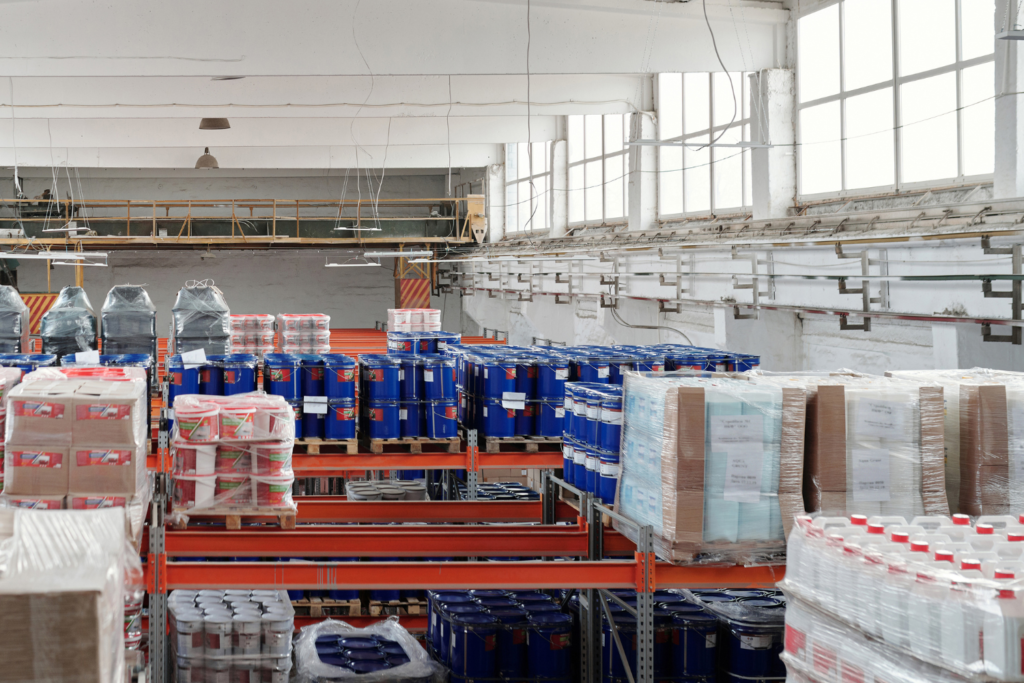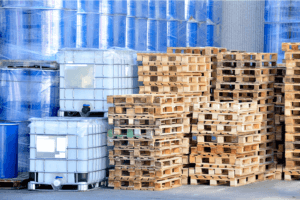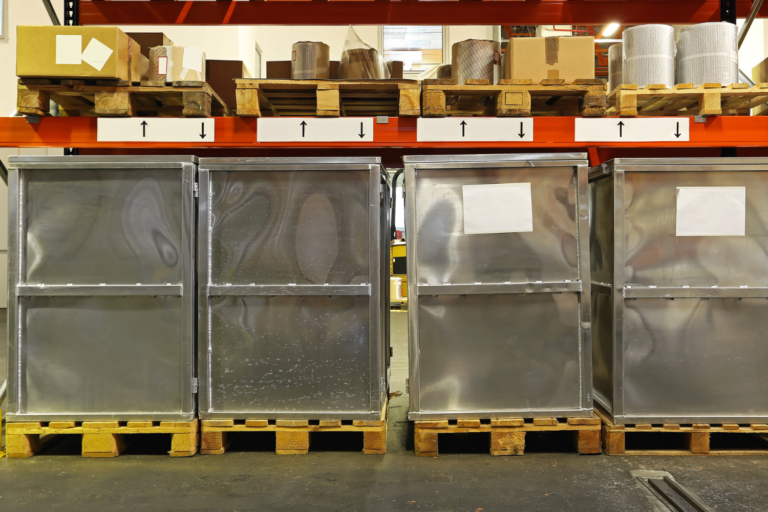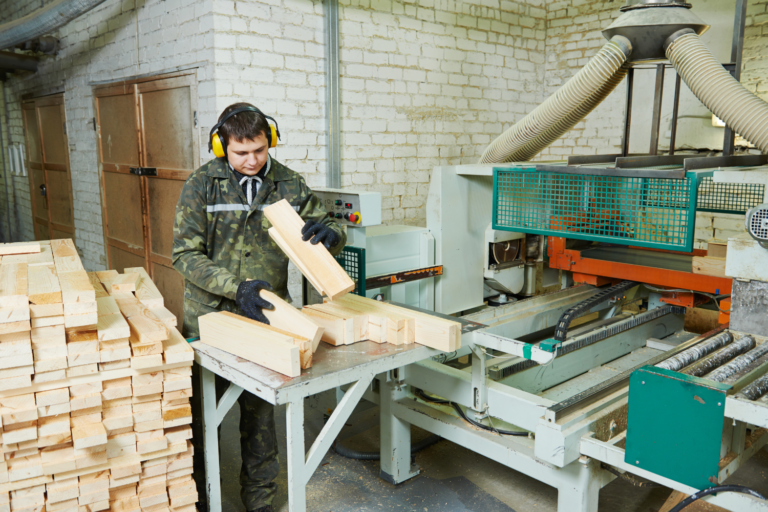Today, pallets are indispensable to global trade, with billions in circulation worldwide. But did you know how they evolved from simple wooden platforms to sophisticated tools of modern logistics?
They continue to adapt to the changing demands of the global economy, providing a reliable foundation for the storage and movement of goods.
As industries evolve and technology advances, they will remain a cornerstone of efficient material handling, ensuring their place in the future of logistics and commerce.
Let us discuss the history of pallets.
A Brief History of Pallets
The history of pallets traces back to the early 20th century when their evolution transformed logistics and transportation.
Before pallets, businesses relied on barrels, boxes, and manual labor for moving goods.
The growing demand for efficient transportation in the early 1900s spurred the development of more organized loading methods.
During this period, skids were used to stack and transport goods.
However, the advent of forklifts in the 1920s prompted a shift towards creating more stable platforms that allowed goods to be easily lifted and moved. This was the inception of the modern pallet.
Pallets began gaining widespread use during World War II as the need to move large quantities of military supplies efficiently became critical.
This led to their standardization, particularly in the United States, where the military developed specific designs to streamline loading and shipping processes.
Post-war industrial expansion saw the adoption of pallets by various industries, cementing their importance in the commercial sector.
The creation of the Grocery Manufacturers Association (GMA) standard pallet in the 1960s revolutionized the industry by establishing a widely accepted specification.
This helped businesses streamline their operations and facilitated the rise of global trade by providing a universal platform for shipping.
Over time, pallets evolved in materials and design to meet diverse industry needs.
Wooden pallets have remained dominant due to their cost-effectiveness and durability, but alternatives such as plastic, metal, and composite pallets emerged to address specific challenges.
Recycled and reusable pallets have become crucial, too, as businesses strive to minimize waste and reduce their carbon footprints.
The rise of automation and modern logistics systems in the 1980s and 1990s saw them becoming more refined.
Businesses increasingly relied on barcodes and RFID technologies to track and manage goods.
Pallet pooling systems, which allow companies to rent pallets instead of owning them, also gained popularity and reduced costs while improving pallet quality and availability.

Who Discovered Pallets?
The first known patent related to pallets was granted in 1925 to Howard T. Hallowell, who invented what he referred to as a “Lift Truck Platform.”
This invention was essentially a wooden platform designed to be lifted by a forklift. It had a double-faced design with slats.
His invention provided a more organized way to stack and transport goods using machinery, capitalizing on the growing adoption of forklifts at the time.
However, the concept of using platforms for moving goods dates back much further. The ancient Egyptians used wooden sledges around 1,000 years BC to transport heavy objects.
Ancient Egyptians Developed the Concept of Using Platforms for Moving Goods
While the Ancient Egyptians did not invent pallets as we know them today, they did develop the concept of using platforms and rudimentary techniques to move heavy goods.
Historical records and archaeological evidence suggest that they used wooden sledges to transport large stones and other materials for their construction projects, such as the pyramids.
These sledges were essentially flat platforms with runners underneath, allowing workers to drag heavy loads across the ground.
To reduce friction, they often poured water or lubricated the sand in front of the sledges.
This early use of platforms demonstrates a fundamental understanding of how to transport heavy items efficiently, although they are quite different from modern pallets.
The basic idea of placing goods on a stable platform for easier transport and minimizing human labor was certainly in practice, showing that they recognized the need for systematic handling of materials.
While these methods were not direct predecessors to today’s pallets, they are part of a broader lineage of ideas focused on improving the handling and transportation of goods.

What Were the First Uses of Pallets?
The first uses of pallets were closely tied to the emergence of forklifts in the early 20th century and the need to enhance material handling in warehouses and transport facilities.
Initially, pallets, which were then in the form of simple wooden platforms or skids, were utilized to lift and transport goods more efficiently than manual labor alone.
Their primary role was to create a stable platform for stacking goods that could be easily lifted by the new forklifts, which were gaining popularity in industrial settings by the 1920s.
During World War II, pallets found widespread use as military logistics became a critical challenge.
The war effort required rapid movement of vast quantities of supplies, such as ammunition, food, medical supplies, and equipment.
This wartime necessity led to the development of standardized pallet sizes and designs, which became the foundation of their commercial use after the war.
In addition to military logistics, early uses of pallets in commercial industries included warehousing and manufacturing sectors, where they were employed to organize and move products more effectively.
They enabled companies to stack goods in an orderly fashion, reducing the damage caused by rough handling and improving the efficiency of storage space.
Pallets During the World War 2
Pallets played a crucial role during World War II. As the war intensified, the efficient movement of supplies became essential to sustain military operations.
The U.S. military needed to transport vast amounts of food, ammunition, medical supplies, and equipment. They used pallets as well as forklifts to make the process easy for them.
The combination of pallets and forklifts enabled them to load and unload supplies up to ten times faster than traditional methods.
Soldiers could now quickly deploy or resupply, which had a direct impact on the success of operations.
This innovation greatly influenced military supply chains and set the stage for modern logistics.
As soldiers returned to civilian life, they brought with them the knowledge and practices of palletized logistics, which were quickly adopted by private industries.
Businesses recognized the cost and labor savings that pallets offered, leading to their widespread adoption across various sectors.

How Pallets Are Used in the 21st Century
Now that you know the history of pallets, how are they used today?
In the 21st century, pallets have become versatile tools beyond their traditional roles in storage and transportation. Below is a closer look at how pallets are used today.
1. Storage
Pallets continue to be the backbone of storage solutions in modern warehouses and distribution centers.
The standardization of their sizes helps businesses optimize their racking systems and automate warehouse operations, which has become crucial with the rise of e-commerce.
2. Transportation
Pallets still serve as the foundation for moving goods across the globe. They stabilize loads, reduce product damage, and streamline the loading and unloading processes.
Advancements in technology have led to the incorporation of pallet tracking devices, enhancing the visibility and traceability of shipments throughout the transportation process.
3. Flooring
Pallets have gained popularity in creating affordable and durable flooring solutions, especially in industrial and rustic-themed spaces.
Their sturdy wooden slats can be repurposed to form unique and cost-effective floors for workshops, patios, sheds, or event spaces.
With a little modification, pallet wood is also used to create outdoor decking areas or temporary flooring for events and exhibitions.
This trend has been embraced by businesses and homeowners alike, capitalizing on the natural aesthetic of reclaimed wood and its eco-friendly appeal.
4. Decorations
In recent years, pallets have made their way into interior and exterior decor.
They have become the go-to material for creating rustic and industrial-style furniture, such as coffee tables, bookshelves, bed frames, and wall-mounted racks.
The rugged charm of pallet wood, combined with its low cost, has inspired many DIY enthusiasts to design functional yet stylish pieces.
Pallet-based decorations can be seen in homes, cafes, and outdoor spaces, where their versatile design offers a blend of practicality and creativity.
5. Other DIY Projects
Pallets have become one of the favorite resources for DIY enthusiasts due to their accessibility and flexibility.
They are repurposed for numerous projects, from garden planters and compost bins to playhouses and outdoor furniture.
Some utilize them to construct fences, pet beds, bike racks, and more. Here is a list of the DIY projects you can start with pallets.

Conclusion
The turning point in the widespread adoption of pallets came during World War II when their use became essential to the military’s logistical efforts.
The war highlighted the efficiency of palletized transport, enabling faster loading and unloading of supplies and significantly reducing manual labor.
The standardization of pallet designs during this period laid the groundwork for their post-war expansion into the commercial sector.
After the war, the use of pallets spread rapidly, as industries recognized their potential to streamline storage and shipping processes.
If you need pallets for your business, check out our pallet products here.
Chesapeake Pallets has been helping companies across the United States level up their logistics, one pallet at a time.
For inquiries, email info@chesapeakepallets.com or request a quote below!
















